OUR BURNING PLANET OP-ED
Unique Pleistocene landscape likely to be doomed by proposed Thyspunt nuclear site — here’s an alternative vision

The National Nuclear Regulator wants a nuclear power plant at Thyspunt in the Eastern Cape. With an archaeological record spanning about a million years of human evolutionary history in an intact landscape and shoreline, Thyspunt is a sacred place that has meaning for all seven billion of us humans. Why not envisage a future that builds on the innate strengths of the area rather than one that will degrade them by building a huge edifice to an outdated technology?
Professor Richard Cowling is emeritus professor of ecology at Nelson Mandela University. He is locally and globally recognised for his research on the evolution and conservation of diversity in Cape biomes, the ecological resources that sustained human evolution on the Cape coast, and the restoration of degraded ecosystems. He divides his time between surfing, botanising and thinking about how to dampen the effects of the looming socio-ecological dystopia.
Let us put aside for a moment the objections to siting a nuclear facility at Thyspunt that relate to the social and economic costs of this project; or the potential for corruption; or that nuclear energy is a grotesque 20th-century relic that has no place in a world striving for peace and coexistence of all its species.
It’s Heritage Month, so let’s instead focus on the natural and cultural values of Thyspunt, and how these will be irreversibly degraded by emplacing in this wild, wonderful and dynamic place a huge infrastructure build. Let’s instead ponder a future for the site that is based upon its unique features, a future that delivers redress to people of Khoe-San descent, and a future that will see Thyspunt rightfully recognised as a cultural and natural landscape of global significance.
Thyspunt has three features that qualify it as a place of global import. These are a cultural landscape of unblemished integrity that offers witness to almost a million years of human history, including the transition to human modernity in the Middle Stone Age; a network of wetlands that are regarded by experts as one of a kind; and mobile dunefields that are unique globally in their extent and preservation.
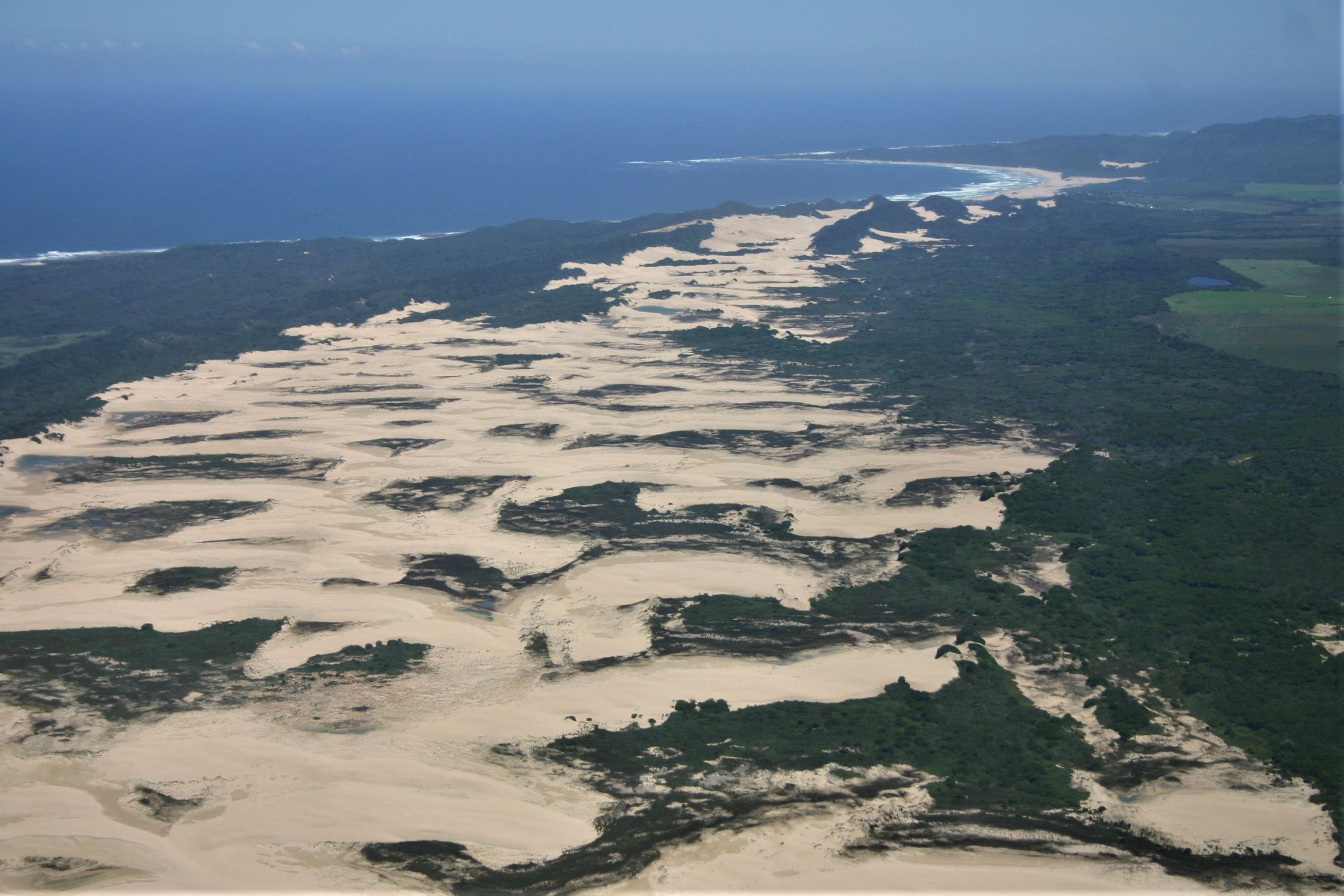
Looking west over the Oyster Bay dunefield, one of two headland bypass dune systems on the Thyspunt property. Not only are these dune systems globally unique, but they are also home to a rich archaeological record that is exposed by the ever-shifting sands. The slacks between the transverse dune ridges support wetlands that wax and wane with wet and dry rainfall periods, respectively. There is a proposal to prospect for sand mining in both the Oyster Bay and Thys Bay dunefields. (Photo: Richard Cowling)
Little wonder then, that based on the Environmental Impact Assessment (EIA), the Department of Environment, Forestry and Fisheries chose Duynefontein over Thyspunt as the preferred site. But the absence of environmental authorisation for a nuclear build at Thyspunt has not deterred the National Nuclear Regulator from seeking a licence to do so.
Despite the irreplaceable features of Thyspunt, the Summary and Impact Assessment chapters in the EIA report are enthusiastic about a nuclear build there. The Impact Assessment concludes that “the proposed NPS (at Thyspunt) could accordingly be developed without a material reduction in the ecological value”.
Really? The arrival at such a conclusion is a function of cynical manipulation of the scoring system used in the EIA. The summary and assessment reports display contradictions, obfuscations and manipulations of evidence and data that are suggestive of bias in favour of the development. The real picture from the specialist reports on heritage, wetlands and dune geomorphology, is that the consequences and likelihood of substantive impacts on these are of such a magnitude that they are fatal flaws. In the parlance of the Department of Environment, Forestry and Fisheries, a fatal flaw is “any problem, issue or conflict (real or perceived) that could result in proposals being rejected or stopped”.
In this article, I identify three flaws of sufficient gravitas to sink forever the notion of a nuclear build at Thyspunt.
Cultural heritage
Thyspunt forms part of a series of archaeological sites along South Africa’s south coast that hold evidence, unparalleled elsewhere in the world, of the emergence of cognitively modern humans. The trace of the behaviours of the ancestors of all seven billion of us can be seen in the mobile dunes and coastal scrub at Thyspunt. Nowhere else is all this archaeology — spanning Early, Middle and Late Stone Age cultures — located in a pristine environment that can showcase the resources (shellfish, bulbs, game) that underpinned human sustenance, innovation and persistence.
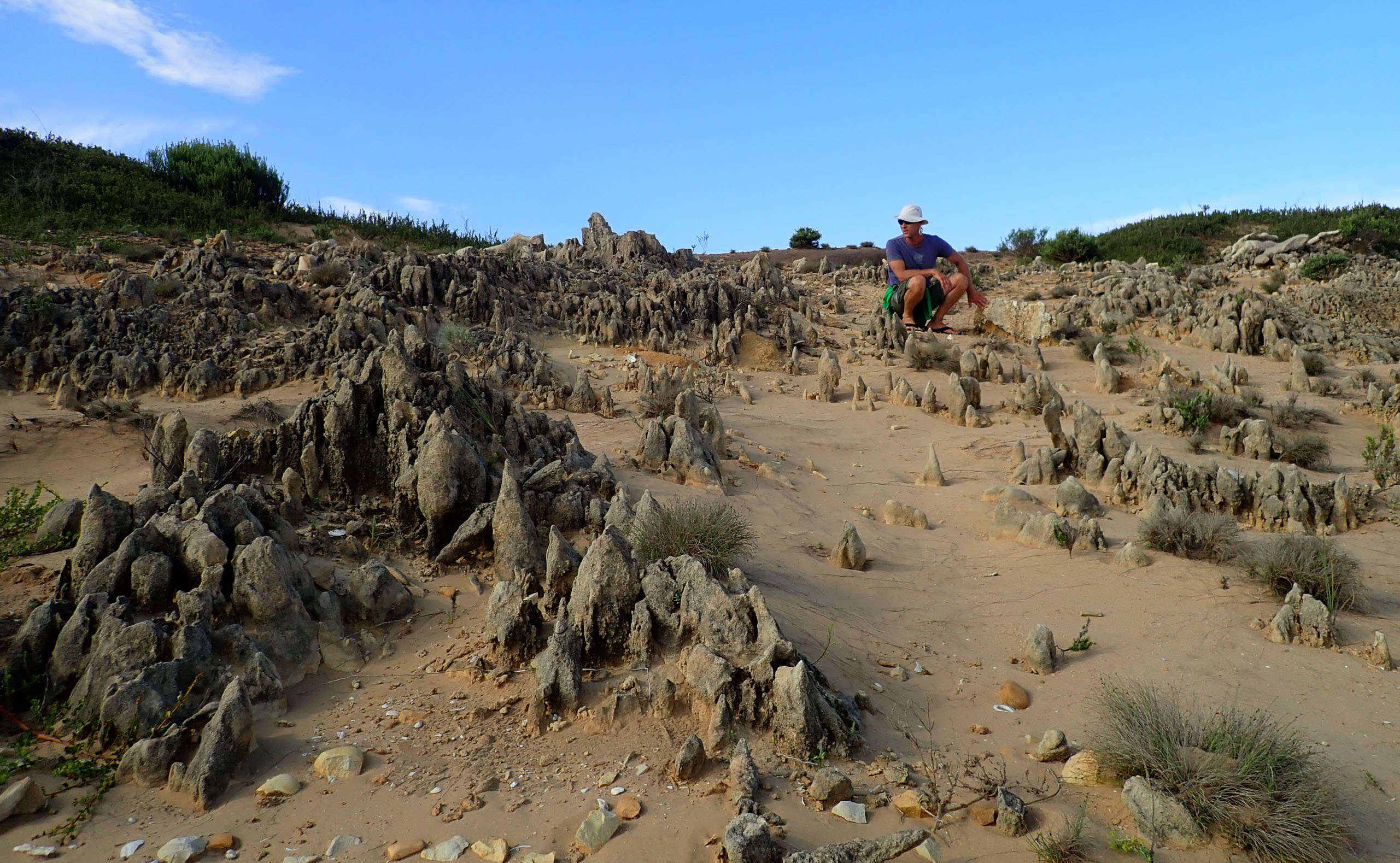
The calcified trunks of forest trees (kershout and milkwood) exposed in the Thys Bay bypass dunefield. The trees grew on an ancient dune, likely dating to the last interglacial, about 100,000 years ago. Note the Middle Stone Age tools in the foreground. Early modern humans would have sought shelter in these forests where they processed shellfish, bulbs and game for sustenance. (Photo: Richard Cowling)
The heritage report of the Thyspunt EIA had this to say about the site: “The cultural landscape significance of the place relates mainly to its superb natural heritage, pre-colonial heritage, setting and contribution to the wilderness qualities of the region.” The report further states “in terms of the Unesco definition of a ‘cultural landscape’ — a distinct area containing the combined works of nature and people — Thyspunt and environs is a uniquely intact pre-colonial cultural landscape that contains the intact evidence of how pre-colonial people used the landscape — a complete settlement pattern.”
It goes on to state that “the wilderness qualities of this portion of the coast in contiguity with the archaeological heritage are exceptional and make a substantial contribution to the character of the region. Given the mass and bulk of the proposed activity, unmitigatable cultural landscape impacts are expected.”
In other words, the proposal for the Thyspunt site is fatally flawed. And yet the residual risk of the impact analysis in the EIA report is allocated as “moderate” for Thyspunt.
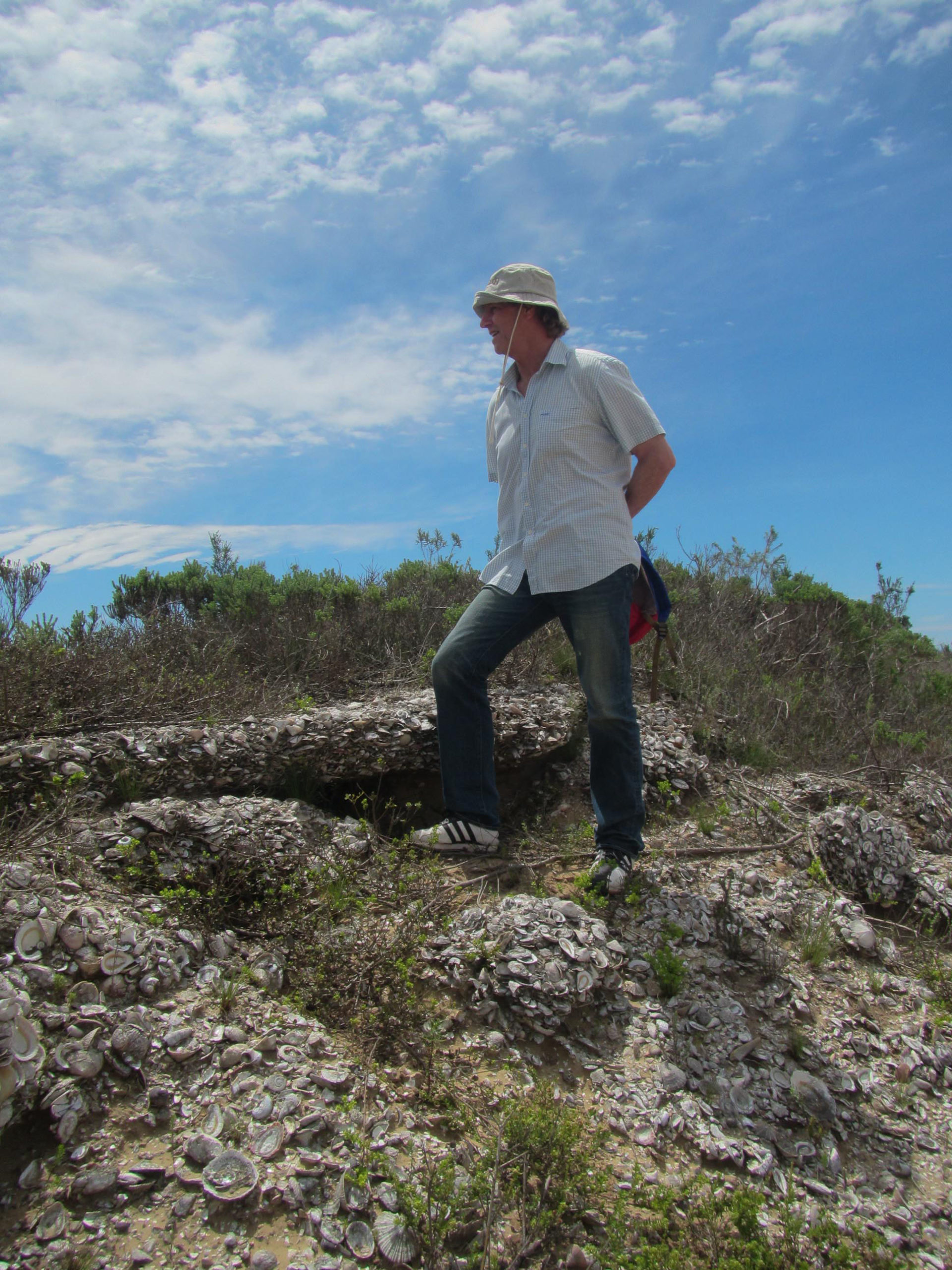
A Later Stone Age shell midden exposed in the Thys Bay bypass dunefield. These dunes reveal evidence of human occupation spanning almost a million years from Early Stone Age tools to the mingling of San, Khoekhoe and settler technologies in the early colonial period. (Photo: Richard Cowling)
Freshwater ecosystem heritage
The freshwater ecology assessment in the EIA report makes it clear that the wetlands at Thyspunt are of outstanding conservation value and should not be subject to disturbance that would impair their persistence. Thus, the report states: “The site includes portions of wetlands of extremely high conservation status, which are considered part of a one-of-a-kind system. Any impacts that threaten the interconnected functions or present ecological state of the duneslack wetlands, the permanently vegetated hillslope seeps that include the Langefonteinvlei, the parallel valley bottom wetlands or the coastal seep systems is (sic) considered of high negative significance.” It also states that “the wetlands are considered unique systems that are unlikely to be represented in their present form and complexity elsewhere in the world.”
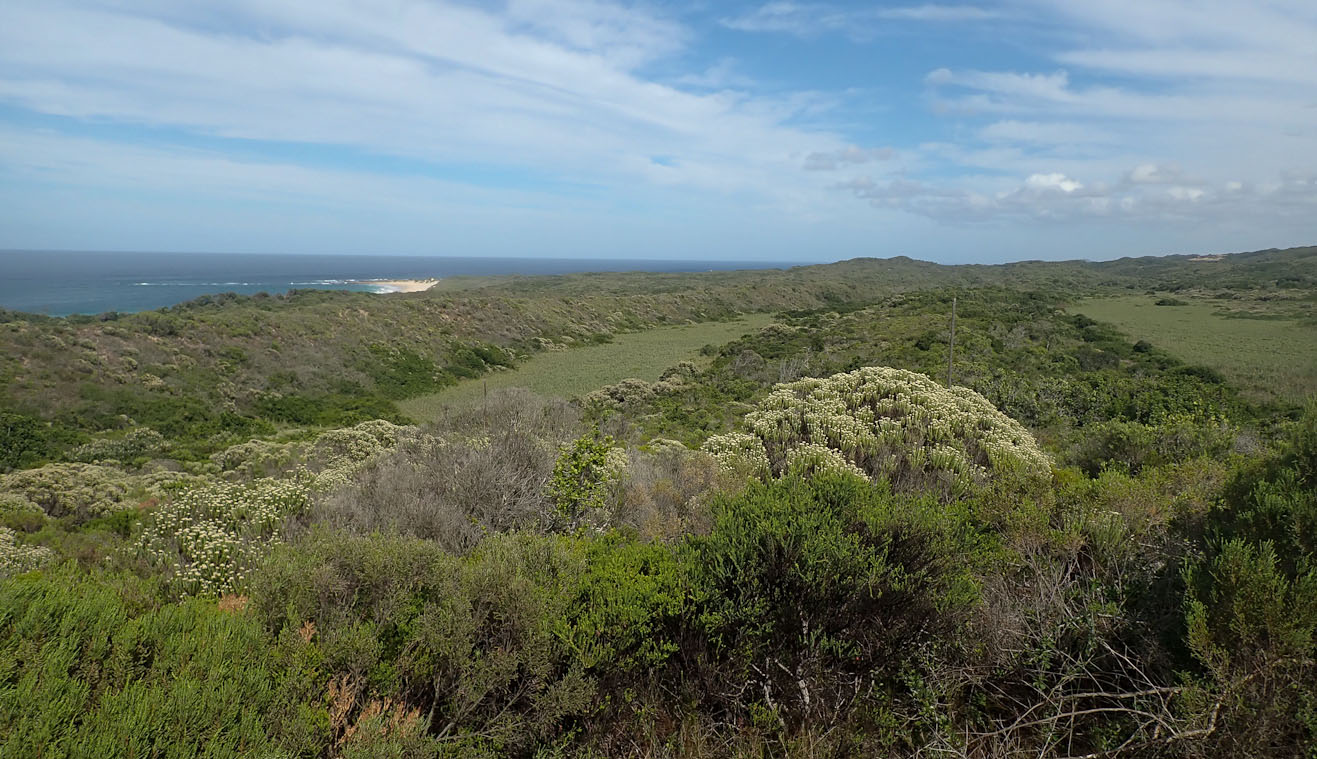
The Langefonteinvlei, a unique dune valley bottom wetland immediately east of the proposed site for the nuclear facility at Thyspunt. There remains high uncertainty on the impacts of the nuclear build on this wetland. The peer- review of the geohydrological study states that the numerical model used by the consultant is unconvincing as a tool to simulate water drawdown impacts of the build on this wetland system. (Photo: Richard Cowling)
Amazingly, the assessment chapter of the EIA report allocates a low probability to the loss of Langefonteinvlei wetlands both with and without mitigation. This is despite the Wetland Monitoring Report acknowledging that the excavation for the nuclear facility could result in a drawdown of moisture, reducing flows into the wetland, that will result in “an irreversible loss of the… wetland habitat”. Another fatal flaw.
Dune heritage
The dune geomorphology specialist report — a contradictory assessment deficient in data and underpinned by an outdated literature — found no fatal flaws in the proposed build. On the one hand, the assessment states that: “the geomorphologic conservation value of the headland-bypass dunefields at Thyspunt is high, as they are the only remaining large dunefields of this type that are still active in South Africa. The headland-bypass dunefields… are unique on a local, regional and probably global scale”.
On the other hand, it sanctions a haul road and transmission lines across the mobile sand of this dunefield. The impact assessment chapter in the EIA report states that these impacts, without mitigation, are of high consequence and high probability, in other words representing a fatal flaw. The mitigation measures proffered by the report are untested and unconvincing.
Beyond the no-go argument
An intriguing feature of the EIA report is the argument by the biophysical specialists that the no-go alternative would degrade the Thyspunt area more than the construction of a nuclear facility. They envision that unmanaged and rampant coastal resort development will destroy and fragment natural and cultural heritage resources more than what has been described by Trudi Malan of the Thyspunt Alliance as the largest infrastructure build in the Southern Hemisphere. This is an assumption. There are no data in the EIA report confirming that “development trends, according to the specialists, shows (sic) no indication that the no-go alternative would result in these impacts slowing down or ceasing”.
In actual fact, the Thyspunt property is identified as being part of a Critical Biodiversity Area by the Garden Route Biodiversity Sector Plan, and a priority for protected area expansion by the Eastern Cape Parks and Tourism agency, two facts not mentioned anywhere in the EIA. In terms of planning guidelines, Critical Biodiversity Areas are regarded as no-go areas for development that degrades biodiversity value.
Furthermore, a vigorous and well-informed civil society would oppose plans for developing the area with as much energy and dedication as they have opposed the nuclear facility. Therefore, achieving a favourable record of decision for a development is highly unlikely, given the biophysical and cultural uniqueness and hydrological complexity of the site. The no-go scenario invoked in the EIA is misinformed and misleading.
An alternative vision for Thyspunt
Here I offer an alternative vision for Thyspunt, one that envisages the area’s unique heritage features driving job-intensive, eco-and palaeotourism, and in doing so, provide redress to the Kouga’s people of Khoe-San descent.
The Eskom properties at Thyspunt should be proclaimed a protected area and developed appropriately for low-impact tourism. Where else in the world can one see, in the open, evidence of human ecological and cultural behaviours spanning almost a million years? The resources — shellfish, game, bulbs, berries, wood and rock — whose skilful use enabled modern humans to survive the climatic vicissitudes of the Pleistocene — are there to observe, along with archaeology that is witness to that. An intact cultural landscape. It’s mind-blowing!
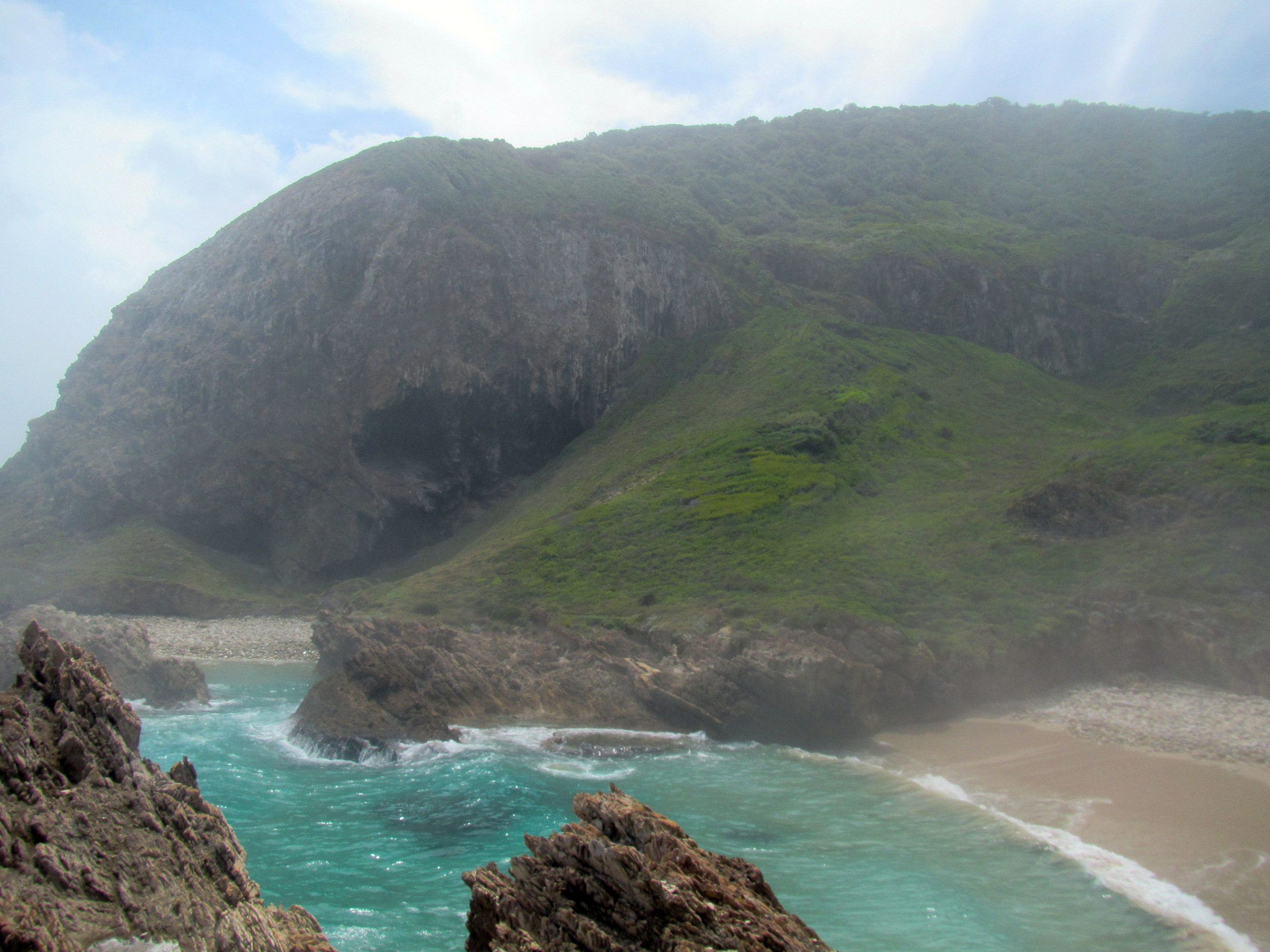
Klasies River Caves, dubbed by the renowned archaeologist, Hilary Deacon, as the oldest seafood restaurant in the world. Based on their archaeological and other palaeoarchives, the caves are in the process of being proclaimed a World Heritage Site. Thyspunt complements Klasies as a paleotourism landscape since it demonstrates open-site as opposed to cave-based behaviours of hunter-gatherers. (Photo: Richard Cowling)
Of crucial importance is that the benefits of tourism enterprises are shared with the Khoe-San people of the Kouga. They are the direct descendants of the earliest modern humans. Everywhere they have had their cultural landscapes carved up, sold off and often irreversibly degraded.
So, let’s embrace a 21st-century approach to Thyspunt: abandon nuclear aspirations, institutionalise protection and promote socially responsible tourism. Let’s plan for a world-class heritage attraction at Thyspunt. DM
Disclaimer: Prof Richard Cowling is a founding member of the Thyspunt Alliance, which has actively opposed a nuclear facility at Thyspunt. He lives at Cape St Francis; thus, Thyspunt is in his backyard.





















 Become an Insider
Become an Insider
Thank you for sharing this with us. Designation of the site for nuclear may be a blessing in disguise. Nuclear power plants are likely to remain unaffordable for a long time, perhaps forever. In the meantime, the site will be protected from development, due to the need to maintain an exclusion zone around the proposed site for the plant.
Compellingly and lucidly presented argument to preserve this outstanding and unique site from inappropriate development of any kind. This current ANC government, especially the Energy Department and Gwede Mantashe, is mind boggling in its insistence on going ahead with massive infrastructure projects. This is despite the incontrovertible evidence from Medupi and Kusile that such projects fail to deliver the promised outcomes – whether energy generation, employment, skills building or economic benefits – despite massive cost overruns. The only reason Medupi is even half working is because of expensive re-engineering by Eskom that has contributed to its unaffordable debt burden. Don’t carry on making the same mistake again and again please government.
Wonderful article giving the facts and the future of such an incredibly important landscape! Much must be done to raise awareness of the terrible loss should either a nuclear build or coastal development destroy this priceless landscape…. As the author states, this is not an either/or debate, there are other options!
We have three of the richest men on the planet playing space games while the world burns… shades of Ancient Rome, Nero?